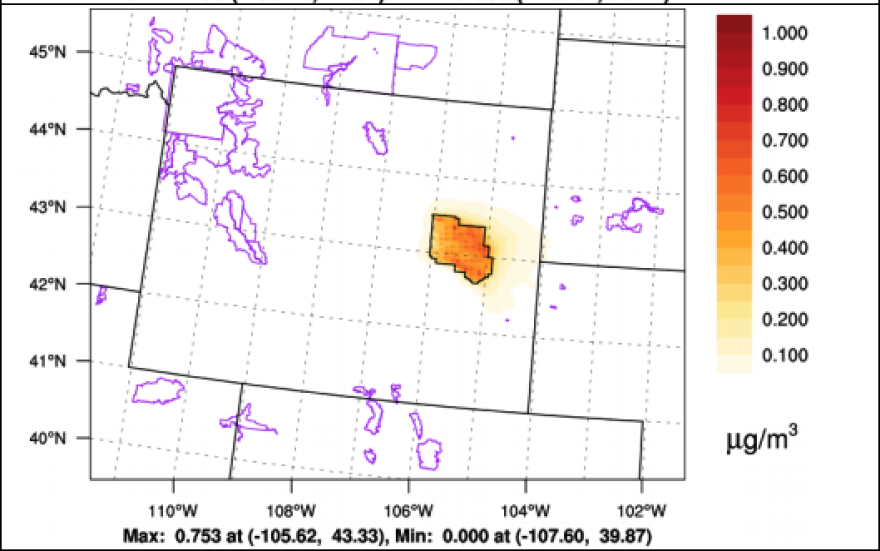In official comments, the U.S. Environmental Protection Agency raised concerns about how the Bureau of Land Management analyzed and presented air quality impacts for the recently-approved Converse County Oil and Gas Project.
"Key sections of the Final [Environmental Impact Statement]… inaccurately present and apply EPA's analytical methods for comparing the air quality model results to the [National Ambient Air Quality Standards] for some pollutants and model scenarios," read the comments.
On Dec. 23, 2020, the U.S. Department of the Interior issued a record of decision allowing the Converse County Oil and Gas Project to move forward. The decision paved the way for five companies to pursue up to 5000 wells in eastern Wyoming over a ten-year period. The project area encompasses 1.5 million acres, 64 percent of which is administered by the BLM.
The project was proposed back in 2014 and analysis has continued since then. At a legislative meeting in November, local and state leaders emphasized the importance of receiving approval for the project prior to Biden's Inauguration Day with concerns that, if a signature didn't come in weeks, it might instead take years.
The Interior Department has since approved the project, but the BLM's planning website now contains 16 protest letters to the Final Environmental Impact Statement. That includes a letter from the EPA, which was not intended as a formal protest, where the agency reiterates concerns that it states it's raised previously.
Among its concerns, the letter highlighted that the project, as it stands, used a model that underestimates pollution numbers compared to its own results, that the BLM misrepresented its numbers and models, and that the BLM wasn't consistent with federal guidelines in measuring potential maximum operating conditions.
"It's pretty telling that EPA in Region 8 is pushing back and saying, 'Hey, you're running the models in a way that's going to make the project look… that's not going to represent the potential impacts the air quality impacts of the project'," said Allen Robinson, a Carnegie Mellon engineering and public policy professor who researches air quality related to oil and gas.
While the EPA's document was filed Jan. 4, 2021 on the BLM's National NEPA Register, BLM responded to concerns on Dec. 23, 2020 when the ROD was issued.
EPA first highlighted that the BLM stated its model results were processed in accordance with the form of the NAAQS, despite relying on an alternative approach that "did not align with EPA's methods." Concerns included not basing its models off of maximum operating conditions.
Robinson described it as the EPA wanting to see the models if the project were running, "full blast at the same time, you know; what's the worst case?"
The BLM countered in its comments that the EPA's model guidance is designed to estimate impact of sources that remain in a location for years, rather than temporary ones like drill rigs or fracking pumps. The BLM said its approach is consistent in concept with how other similar analyses are done in the state.
The EPA also pointed to an apparent mix-up within the analysis where one section showed an average of model results, say for completions or construction, over 1-year; later in the analysis, though, the agency points out that the analysis states the approach accounts for a 3-year average. The BLM didn't address this situation in its comments.
The EPA also found BLM's modeling predicted air quality impacts were lower than its own. In both scenarios though, three pollutants violated a federal standard, in National Ambient Air Quality Standards (NAAQS).
The BLM pointed to previous comments saying its model was based on "conservatively high impacts for a majority of the scenarios and activities analyzed."
Robinson said it's impossible to say what the air quality impacts of the project will be at this point.
"It's set up to be conservative," he said. "My read of this is that they haven't been as conservative as EPA would have liked, which creates a higher probability that the air quality may be poor."
Lastly, the EPA recommended the operators commit to certain equipment in order to mitigate air quality impacts. The BLM responded that those operators have already committed to a certain type of engine.
"The BLM may rely on the State of Wyoming, which is subject to oversight by the EPA, to ensure permitted activities do not exceed or violate any state or federal air quality standards under the Clean Air Act," BLM comments read.
In a separate request for comment, Richard Mylott, EPA Region 8 spokesperson, said the EPA is a cooperating agency and doesn't approve or deny projects. Its comments were intended to "inform future BLM air quality modeling efforts and potential actions to further reduce projected impacts."







